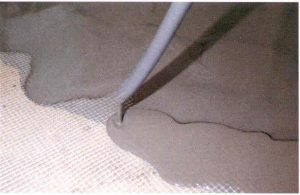Screed
Property
Components
Dense Concrete Floor Screed/ Cementitious Screed
The proportion of screed components is derived from 3 categories of screeds:
- Monolithic screed (on green concrete)
Screed, which is laid on an in situ concrete base before it has set (within 3 hours of placing). In this case, a complete bonding is obtained.
- Bonded screed (on hardened concrete/ precast concrete)
This is also known as separate construction and bonding agent may be used to ensure maximum bond with the base. Before the application, concrete base must be wet but free from excess water.
- Unbonded screed
Unbonded construction is adopted when the screed is laid on the damp proof membrane or when the concrete contains water repellent admixture.
- Floating screed
This type of screed is unbonded to concrete base and is designed as floating screed to accommodate heating elements or sound insulations.
Suitable mix proportion by weight is shown in the table below:
| Type of Screed | Thickness of screed (mm) | Cement | Fine Aggregate (dry sand and crushed stoned graded 5mm down) | Coarse Aggregate (graded 10mm down) |
| Monolithic screed | 12-25 | 1 | 3 – 4.5 | – |
| Bonded screed | 25-40 | 1 | 1.5 – 4.5 | =< 3 |
| Unbonded screed | 50-60 | 1 | 1.5 – 4.5 | =< 3 |
| Floating screed | 60-70 | 1 | 1.5 | 3 |
- The richer 1:3 mix is preferred for thin floor covering, such as PVC (vinyl)-asbestos and flexible vinyl tiles.
- Mixing process is the most important to obtain optimum strength, therefore a mechanical mixer is advisable.
- Sand Grading limits should be specified according to sieve sizes to BS 410.
- Fine aggregate should comply with BS 882, whereas the coarse aggregate should also comply with the grading limit of Table 3 in BS 882.
Proprietary Floor Screed
These factory pre-pack dry screeds are basically dense screed modified by inclusion of materials in emulsion form. They are either cementations based or calcium sulfate, and usually some admixtures (e.g.: Epoxy or PU) are incorporated to enhance the performance of the screed. The installation procedure should follow closely to the manufacturer’s guide.
However, the calcium sulfate based screed is seldom used because of its weakness and its low water tightness. This type of screed is normally meant for temporary use only. The Epoxy and PU based screed are relatively more expensive, but for special cases it’s preferred because of its strength (can be higher than 70-100 MPa) and it is fast-cured.

Thermal Conductivity
Thermal conductivity is about 1.83 W/mK
Density
Depending on the type of the screed, the density of screed range between 1600 to 2100 kg/m³
Coefficient of Linear Thermal Expansion/°C
10 to 13 x 10-6
Reversible Moisture Movement
0.02 – 0.06%
Drying Shrinkage
0.03- 0.04%
Fire Resistance
Screed is considered non-combustible material